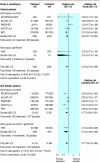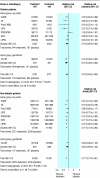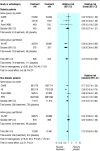Efficacy of lipid lowering drug treatment for diabetic and non-diabetic patients: meta-analysis of randomised controlled trials
- PMID: 16585050
- PMCID: PMC1459619
- DOI: 10.1136/bmj.38793.468449.AE
Efficacy of lipid lowering drug treatment for diabetic and non-diabetic patients: meta-analysis of randomised controlled trials
Abstract
Objective: To evaluate the clinical benefit of lipid lowering drug treatment in patients with and without diabetes mellitus, for primary and secondary prevention.
Design: Systematic review and meta-analysis.
Data sources: Cochrane, Medline, Embase, and reference lists up to April 2004.
Study selection: Randomised, placebo controlled, double blind trials with a follow-up of at least three years that evaluated lipid lowering drug treatment in patients with and without diabetes mellitus.
Data extraction: Two independent reviewers extracted data. The primary outcome was major coronary events defined as coronary heart disease death, non-fatal myocardial infarction, or myocardial revascularisation procedures.
Results: Twelve studies were included. Lipid lowering drug treatment was found to be at least as effective in diabetic patients as in non-diabetic patients. In primary prevention, the risk reduction for major coronary events was 21% (95% confidence interval 11% to 30%; P < 0.0001) in diabetic patients and 23% (12% to 33%; P = 0.0003) in non-diabetic patients. In secondary prevention, the corresponding risk reductions were 21% (10% to 31%; P = 0.0005) and 23% (19% to 26%; P < or = 0.00001). However, the absolute risk difference was three times higher in secondary prevention. When results were adjusted for baseline risk, diabetic patients benefited more in both primary and secondary prevention. Blood lipids were reduced to a similar degree in both groups.
Conclusions: The evidence that lipid lowering drug treatment (especially statins) significantly reduce cardiovascular risk in diabetic and non-diabetic patients is strong and suggests that diabetic patients benefit more, in both primary and secondary prevention. Future research should define the threshold for treatment of these patients and the desired target lipid concentrations, especially for primary prevention.
Figures









Comment in
-
Diabetes and lipid lowering: where are we?BMJ. 2006 May 13;332(7550):1103-4. doi: 10.1136/bmj.332.7550.1103. BMJ. 2006. PMID: 16690643 Free PMC article. No abstract available.
-
Lipid lowering drugs in diabetes: lipid lowering has ophthalmic benefits.BMJ. 2006 May 27;332(7552):1272-3. doi: 10.1136/bmj.332.7552.1272-b. BMJ. 2006. PMID: 16735343 Free PMC article. No abstract available.
-
Lipid lowering drugs in diabetes: absolute risk reduction is what counts.BMJ. 2006 May 27;332(7552):1272. doi: 10.1136/bmj.332.7552.1272-a. BMJ. 2006. PMID: 16735344 Free PMC article. No abstract available.
-
Lipid lowering drugs in diabetes: abstract was misleading.BMJ. 2006 May 27;332(7552):1272. doi: 10.1136/bmj.332.7552.1272. BMJ. 2006. PMID: 16735345 Free PMC article. No abstract available.
References
-
- Beckman JA, Creager MA, Libby P. Diabetes and atherosclerosis: epidemiology, pathophysiology, and management. JAMA 2002;287: 2570-81. - PubMed
-
- Haffner SM, Lehto S, Ronnemaa T, Pyorala K, Laakso M. Mortality from coronary heart disease in subjects with type 2 diabetes and in nondiabetic subjects with and without prior myocardial infarction. N Engl J Med 1998;339: 229-34. - PubMed
-
- Miettinen H, Lehto S, Salomaa V, Mahonen M, Niemela M, Haffner SM, et al. Impact of diabetes on mortality after the first myocardial infarction. Diabetes Care 1998;21: 69-75. - PubMed
-
- UK Prospective Diabetes Study Group. Effect of intensive blood-glucose control with metformin on complications in overweight patients with type 2 diabetes (UKPDS 34). Lancet 1998;352: 854-65. - PubMed
-
- Turner R, Cull C, Holman R. United Kingdom prospective diabetes study 17: a 9-year update of a randomized, controlled trial on the effect of improved metabolic control on complications in non-insulin-dependent diabetes mellitus. Ann Intern Med 1996;124: 136-45. - PubMed
Publication types
MeSH terms
Substances
LinkOut - more resources
Full Text Sources
Medical
Miscellaneous
